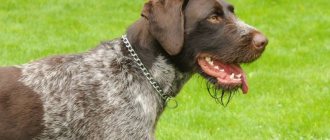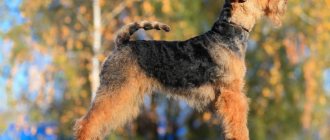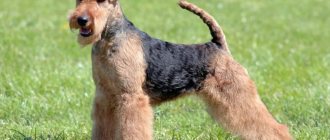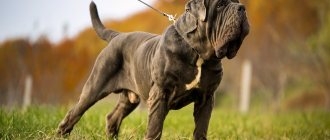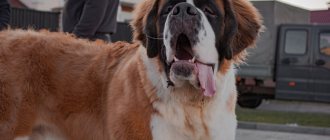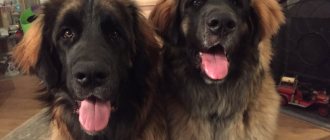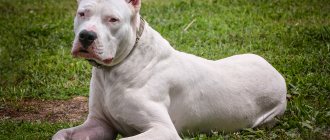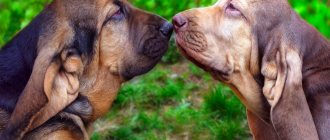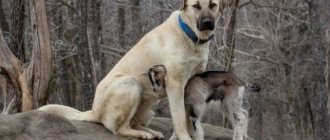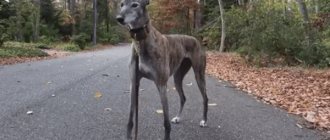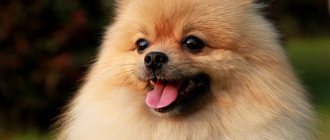- Dogs
Rottweilers are distinguished by their large size and overall massive build. The size and weight of a Rottweiler in the first months of life increases at a record rate. By the age of six months, the Rottweiler’s weight increases 10 times, and its height increases 3 times. With such size, the Rottweiler tends to consider itself superior to humans. Therefore, training such a dog is simply necessary.
Breed standards
A dog can be medium-sized or large and powerful. At the same time, the dog does not look heavy or, on the contrary, light. He is rather lean and hardy. The Rottweiler's weight can range from 45 to 55 kg, depending on gender, and its height ranges from 55-65 cm in females and from 60 to 70 cm in males. They are characterized by a stretch index from 103 to 105.
Rottweiler puppy age 3 months
The skull is of medium length, widening between the ears, the occipital protuberance is well developed, but not excessively. The lips usually have a black color, a tight fit, and the corners of the mouth are well closed, the jaws are wide. It is better if the dog has dark gums, although this is not the most important thing.
It is important that the ears of this breed are hanging, triangular, and set high. Typically, the Rottweiler has dark brown almond-shaped eyes. A characteristic feature of the breed is rounded paws, gathered in a ball, curved toes, with short, strong black claws.
Rottweilers' coats are usually hard and dense, and the undercoat is not visible. As a rule, the dog is black in color with red-brown markings located on the face, collar area and chest, on the paws and under the tail.
Periods of development
Newborn puppies weigh 450-700 g. By the end of the first month of life, they increase approximately 5-6 times. This is the most active period of development. By the second month, the puppy gains about a quarter, and by the fifth, half of its maximum weight.
Newborn babies are black, with barely noticeable markings. Their paws are still small and weak, but already have noticeable claws. The ears are pressed to the head, and the eyes do not see anything.
Further development is divided by dog handlers into periods:
- Infant (1-7 weeks). A one-month-old baby is in dire need of maternal care. He is just learning to use his senses, use his paws, tail, mouth.
- Adaptation (4-7 weeks). Puppies become active and restless: they learn to run and communicate, and actively get to know people and the outside world.
- Socialization (7-12 weeks). The beginning of raising and training a pet: they show the boundaries of what is permitted, teach commands, behavior with people, dogs, and other animals.
- Dominance (12-17 weeks). The young dog becomes strong and independent, which is why he wants to command the “pack”: it is important for the owner to show firmly, but without beating or intimidation, that the man is in charge.
- Independence (4-8 months). The owner patiently teaches the dog the correct behavior and does not allow it to dominate people.
- Period of fear (8-14 months). An animal can be frightened by a seemingly harmless thing, which affects its psyche. The owner, together with the dog, overcomes its fears and makes it clear that the person can always be relied upon.
The mental development of a Rottweiler continues up to 2-4 years. Having reached puberty, the dog may again become nervous and disobedient. The owner stops bad behavior in time, shows his dissatisfaction, but does not use physical violence.
What to do if it lags behind the norm
The first step is to find out the reason why the puppy does not gain weight or height at the withers. If it's all about genetics, then there's hardly anything you can do to help.
If growth is slow due to heredity, owners can be advised to be patient . Apparently, the dog will catch up with the size and weight of its peers, but this will happen a little later.
If the cause of growth retardation is poor quality rearing or an illness suffered by the puppy, then you need to try to eliminate the consequences of the period when the puppy did not receive something as quickly as possible.
There is no need to try to feed such a Rottweiler with special supplements to increase muscle mass or accelerate growth. It is better to consult with a specialist who will select medications that are more suitable for your pet.
IMPORTANT!
If it’s all about an incorrectly chosen diet, then you need to increase the amount of protein products, especially those that contain calcium, such as cottage cheese.
If the dog has previously eaten commercial food, then it is recommended to try a different brand, and it is better to give preference to food of a higher class than the previous one.
Exercising with your dog, especially dragging various objects or carrying loads, can also correct the problem..
It is good if the Rottweiler jumps, runs and swims as much as possible, but, of course, in no case should you overload the dog and bring it to exhaustion.
It makes sense to start worrying that the puppy is not gaining height or weight only if the pet is too far behind the lower limit of the standard and if the Rottweiler has already reached ten months of age, at which point the dog’s growth may actually stop abruptly .
The Rottweiler, like most large dogs, grows in height until the age of one, and gains weight and muscle mass before two or even three years..
Dogs of this breed are predisposed to obesity, and therefore the pet’s weight must be closely monitored, starting from a very early age.
It should be remembered that it is not only feeding that determines what height and weight the puppy will eventually reach after it finally grows up.
Living conditions, training and sports, as well as the correct choice of a pet and its purchase from a good nursery or breeder, significantly reduce the risk that the dog will grow below or above the recommended height standard.
Ideally, the dog’s weight should correspond to its height: only in this case will the Rottweiler be healthy and active, and its life expectancy will also be longer .
Food selection
Having taken your future pet into your home, you need to take seriously the issues of raising and maintaining the puppy. As your household grows, you will become an expert in most topics related to our little brothers, and one of the main and first issues that you will face is the selection of food for the baby.
Eating mother's milk, the cubs received all the necessary microelements and nutrients, and now, when you bear responsibility for the life of the little ones, you need to think and decide what to feed the Rottweiler puppy in such a way as to preserve everything that nature has endowed the little one with and give him what he needs for proper and complete nutrition. growth and development.
One of the main topics of discussion, which is still open to this day, is the question of what kind of nutrition is more balanced and healthy. Each “contender” for the role of the best, and in particular food and so-called natural nutrition, has both its own differences and advantages with disadvantages, which we will now consider. I suggest we deviate from the topic of dogs and talk a little about you, their owners.
For most owners, a passion for animals is not the only hobby and activity; in addition to caring for and raising their pet, a person needs to attend work, communicate, pay attention to his family, if he has one, and, of course, do not forget about himself. But are you ready, in a series of all these responsibilities and events, to devote another part of your time to your ward, for selecting and preparing food for him?
Care and maintenance
You need to comb your dog every week - this will prevent long hairs from tangling, and the fur will be shiny, but it is better to bathe it when necessary. Ears, which can become infected or inflamed, and teeth, which can develop tartar, deserve weekly care. The claws on the paws are trimmed as needed, usually no more than once a month.
Rottweiler puppies on a walk
Rottweiler diseases
The Rottweiler breed is quite capricious; in its representatives, diseases are divided into two types - acquired during life and genetically inherited. The list of ailments is impressive, but it is important to remember that timely diagnosis will help get rid of even the most serious of them.
Diseases are divided into four types: skin, musculoskeletal, neurological and ocular. Skin diseases include eczema and dermatitis, and musculoskeletal diseases include osteochondrosis and hip dysplasia. Diseases of the nervous system typical of the breed are encephalitis and epilepsy, and the eyes often suffer from cataracts, keratitis and conjunctivitis.
Young Rottweiler at home
Skin ailments arise due to insufficient care, unbalanced nutrition, medication, allergies, the influence of parasites, endocrine disorders and household injuries. Eczema causes your Rottweiler to be itchy and scratch incessantly, while dermatitis often results in swollen and red skin.
In both cases, the dog loses its appetite, looks depressed and lethargic, and drinks a lot of water. During this period, the dog needs increased attention and it must be provided. But the main thing is to visit the veterinary clinic on time.
Musculoskeletal diseases can be inherited by Rottweilers. If they were acquired during life, their cause was most likely a poor environmental situation, obesity and a poorly designed diet. You should be wary if the dog refuses to take the poses in which it likes to be, suddenly begins to limp, or even drags its hind legs on the ground.
The first action in these situations is to perform an x-ray or, better yet, an MRI. Depending on how severe the disease is, the Rottweiler is either prescribed medication or sent for surgery.
The Rottweiler has a brave and loyal character.
Neurological disorders arise due to internal malfunctions in the brain, or appear as complications after other diseases. Other causes include infections, stressful situations, and even intestinal parasites. But in 90% of cases the disease is transmitted genetically. Medicines and the help of a qualified specialist will help alleviate the dog’s condition.
Eye diseases are usually caused by viruses, allergies and mechanical damage. Rottweilers are treated with antibacterial drugs under the supervision of a doctor, and in cases of cataracts, surgery may be a last resort.
How to choose a puppy
The Rottweiler is a serious dog that can become dangerous due to mental health issues . Therefore, purchasing this breed from private individuals is not always a good idea. The official nursery provides a guarantee on health and its psychological component. The breeder will help you choose the ideal puppy and tell you about the rules for keeping it. In addition, the nursery will provide a full package of necessary documents, including a pedigree.
To choose the perfect pet, you need to decide on its gender and class. Usually, bitches are more gentle, kinder and more reserved. Males are sharper and more disobedient, but they are better suited for service and protection.
There are three classes of dogs, which primarily determine the animal’s career and its price:
- Pet class – puppies with slight deviations from the standard that do not prevent them from being pets, the lowest price;
- Breeding class – puppies with ideal external characteristics, suitable for breeding and mating;
- Show class – puppies with a good pedigree, descendants of champions with an ideal appearance and set of characteristics, are excellent for a show career.
Rottweiler puppies are always curious, playful and cheerful. They must be healthy and clean. The price depends on the status of the kennel and the class of the dog. Can vary from 12,000 to 60,000 rubles.
A dog can never become a toy. Especially when she is several times larger than a child. The Rottweiler is a serious, large dog that needs to be raised and trained. It is definitely not suitable as a gift for an inexperienced owner.
3.7 / 5 ( 3 voices)
Key points in training
Representatives of the breed are strong and confident. They need a steady hand and a leader. A beginner will not be able to cope with such a dog. The owner must always prove his dominance. Usually the Rottweiler chooses one person to listen to. To avoid such a situation, care for the pet must be divided among all family members, and a schedule for walking and feeding must be drawn up.
Training a puppy begins at 3-4 months, but raising it from birth. The dog must know its place. A person should not allow a dog to eat from the table, beg, or sleep on the master's beds. It is absolutely forbidden to treat an animal roughly, beat it, shout or call it names. A Rottweiler can not only be offended, but also attack in defense. It is best to use the motivational method by luring the puppy with treats or toys. Suitable punishments include deprivation of one meal, gentle jerking, and a stern look.
Read about how to properly train a dog in the article: “Training a puppy: effective methods from dog handlers, learning commands at home.”
The pet must learn its name well before training begins. Usually this happens by 4 months. Then the puppy is already able to learn the necessary commands:
- "It is forbidden";
- "Near";
- "Quiet",
- "Voice";
- "Sit";
- "Place".
You need to take the Dog in the City training course with your dog. It will help adapt the puppy to the conditions of city life, to large crowds of people and cars.
